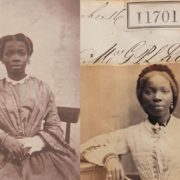A newly commissioned portrait of Sarah Forbes Bonetta is now on view at the monarch’s seaside house, Osbourne
— Isis Davis-Marks, Smithsonian Magazine
A new portrait of Queen Victoria’s black goddaughter, Sarah Forbes Bonetta, is now on view at Osborne, the Hanover monarch’s beloved seaside home.
Per a statement, the painting—created by artist Hannah Uzor—is based on a photograph currently housed at the National Portrait Gallery in London. It’s one of a series of works commissioned by English Heritage to spotlight historical black figures whose stories have previously been overlooked.
— Credits
Featured Image, Sarah Forbes Bonetta, as seen in 1856 (left) and 1862 (right). Hannah Uzor’s new portrait is based on the 1862 photograph. (L: Royal Collection Trust / © Her Majesty Queen Elizabeth II 2020 and R: National Portrait Gallery)
Full article @ Smithsonian Magazine
— Related
Sierra Leone (/siˌɛrə liˈoʊn(i)/ (listen), also UK: /siˌɛərə -/, US: /ˌsɪərə -/), officially the Republic of Sierra Leone, informally Salone, is a country on the southwest coast of West Africa. It is bordered by Liberia to the southeast and Guinea to the northeast. Sierra Leone has a tropical climate with a diverse environment ranging from savanna to rainforests, a total area of 71,740 km2 (27,699 sq mi) and a population of 7,092,113 as of the 2015 census. The capital and largest city is Freetown. The country is divided into five administrative regions which are subdivided into sixteen districts.
Sierra Leone achieved independence from Britain on 27 April 1961, led by Milton Margai, who became the country’s first Prime Minister. Sierra Leone held its first general elections as an Independent nation on May 25, 1962, and Margai’s Sierra Leone People’s Party (SLPP) and its allies won the vast majority of seats in Parliament. Under the leadership of Albert Margai, who was elected by parliament as Prime Minister in 1964 after the death of his brother Milton Margai, SLPP narrowly lost the 1967 Sierra Leone parliamentary election to the main opposition party the All People’s Congress (APC), led by Siaka Stevens, an outspoken critic of the SLPP government.
Source – Sierra Leone (Updated: 07 October 2020) Wikipedia. Available at https://en.wikipedia.org/wiki/Sierra_Leone, (Accessed: 11 October 2020)

